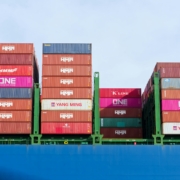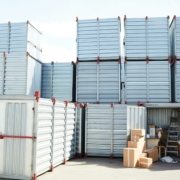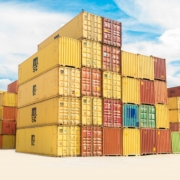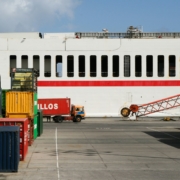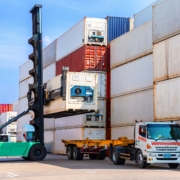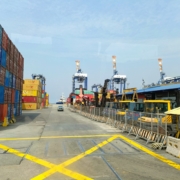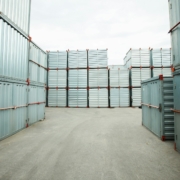Dealing With Storm Damage In Gold Coast Container Storage Facilities
Storm season along the Gold Coast rarely arrives when it’s convenient. One moment it’s blue skies and sunshine, the next you’re dealing with strong winds, sudden rainfall and weather impacts that hit overnight. Container storage yards, especially those fully exposed to the sky, are often hit hardest. Without solid preparation, storage operators can face weeks of disruption from what felt like just a few hours of weather.
Storms bring everything from water damage and flying debris to dented containers and power outages. The real issue? You rarely see the worst of it right away. A subtle leak grows into widespread mould. A minor dent creates alignment issues that stop containers from opening altogether. Reactive fixes often take longer and cost more than the actual event. On the Gold Coast, where forecasts change fast and coastal conditions add pressure, reliable storm readiness can’t wait until the next system rolls in.
Identifying Storm Damage Early
Catching signs of damage early can prevent weeks of complications. The best time to inspect is immediately after it’s safe to walk the yard. Begin the inspection with an eye for both obvious and hidden issues.
Here are areas to check after a severe storm:
1. Roofs and corners of containers for dents or collapsed sections
2. Rust buildup at the base, especially where paint has worn away
3. Door seals and locking mechanisms to confirm full closure and function
4. Interior spaces for signs of mould, damp, or watermarks
5. Fences, gates and wind barriers for dislodgement or breaks
6. Floor grades and drains for any unusual water pooling
These checks can’t wait. Even slight wind shifts can move containers out of alignment. Electronic security systems and powered storage solutions may also need recalibration. Get a clear visual record while inspecting. Photos not only help for insurance claims but provide a reference point for future comparisons.
Not all storms will hit the same way. Often it’s the short ones with high wind bursts that deliver the most unexpected issues. Treat every event as a fresh scenario and don’t assume past outcomes predict today’s damage.
Preventative Measures Before A Storm Hits
Preparation trumps damage control every time. Storm readiness on the Gold Coast can’t be a seasonal task, as wild weather hits outside of defined periods. Getting ahead of it starts with design and layout but is strengthened by consistent upkeep.
Some preventative steps include:
1. Position containers with gaps that prevent funnelling of wind
2. Avoid stacking near trees or structures prone to collapse
3. Secure top containers with proper lock rods and door braces
4. Log container numbers and positions for quick post-storm checks
5. Tie down mobile gear, trailers, and temporary covers
Inspect and repair worn seals, rust-prone joints, or any container fitted with ventilation that’s past its prime. These areas are frequently the first to fail in heavy rain or turbulent wind.
Monitoring weather feeds helps, especially when linked with your existing software. Teams can receive alerts that prompt pre-storm procedures, such as tightening locks or moving containers away from exposed edges. Having a playbook in place saves valuable minutes when warning times are short.
Small actions ahead of time, like redirecting run-off or ensuring drain access, can also make a big difference once the skies open.
Immediate Actions After A Storm
The first hour post-storm is often the most important. Fast assessment leads to faster recovery. Don’t wait for insurers or auditors to begin the basic checks. Start by reviewing safety hazards on site.
Initial steps should include:
1. Walk the yard with someone who knows container placement and exposed zones
2. Document all visible damage using photos with clear angles and time stamps
3. Check interior spaces for water intrusion or early mould
4. Flag breached or risk-prone fencing and restrict access until repaired
5. Map affected stock and separate it quickly to avoid further spoilage
Containers that look unaffected might still contain moisture or structural issues. Even residual dampness can destroy products within days. Open doors where safe to help ventilation, and test mechanical components like latches or hinges for smooth function.
For electric or chilled units, act immediately. Confirm backup systems are working and ensure disconnected power hasn’t ruined the cargo. Don’t wait for signs of spoilage. Proactive inspection means less loss and faster insurance resolution.
One critical step is to resist the urge to clean before documenting. It’s a natural instinct to tidy up and make the area usable, but cleaning too early can damage your case. A quick response backed by complete, time-stamped documentation avoids unnecessary delays in claims and builds credibility with suppliers and insurers alike.
Building Long-Term Storm Resilience
If your container yard feels like it’s constantly playing catch-up after every storm, then long-term changes are overdue. Replacing or repairing the same problem area isn’t a solution. It’s time to upgrade.
Material durability counts. Generic fencing systems used for residential sites won’t stand up to storm winds. Swap them for industrial-rated fixtures with reinforced bases and tested wind resistance. Improve site drainage, particularly around container clusters where air and water flow tend to be restricted.
Consider paving changes, such as grooved layouts or the addition of sump channels. These can help direct run-off away from critical areas quickly.
Training plays a large role in storm resilience. It’s not only the operations manager who should know lockdown procedures. All team members should understand what to secure, where the tie-downs go, and how to document damage without delay. Quick drills during normal weeks keep the crew prepared and reduce panic during real alerts.
Partnerships matter too. Having pre-approved service providers who can patch, weld, or pump water out within hours gives you a huge edge. Build those contacts now, not while standing knee-deep in flooded stock.
Securing Your Containers on the Gold Coast
Doing business on the Gold Coast comes with its own logistics considerations. Between the salt air, fast storms, and changing terrains, protecting container storage goes beyond the basics. Every site layout should factor in local risks from the ground up.
Coastal yards, for example, are more prone to salt-driven corrosion. Inland yards may suffer from poor runoff or blocked access routes during rain. Adjustments in drainage, elevation, and fencing can help each problem area without major site reworks.
Make the most of local tools. City council flood maps can give insights into risk-prone areas within your storage plot. You can cross-reference this info when planning container rows, setting power paths, or even just selecting where trucks load and unload after heavy rain.
Collaborate with neighbouring businesses. Joint storm drains, staggered shift times, or shared security teams can work well for industrial clusters, especially if you’re not operating at full occupancy.
Container transit delays post-storm are another concern. The further your storage yard is from the pickup point or port, the likelier you’re going to run into timing issues when weather hits. Consider location when choosing partners or new yard areas to reduce friction when fast access matters most.
A good Gold Coast storage yard is more than just secure. It’s well-drilled, correctly equipped, and designed with the area’s risks in mind.
Stay Protected Through Thick and Thin
Storms don’t wait. They show up without warning and test your preparation instantly. But if your container yard is ready before the skies turn, every flood warning or wind advisory won’t feel like a setback.
Storm protection for container storage on the Gold Coast begins with early detection, smart layout, and team preparedness. When routine safety checks and planned upgrades are part of the workflow, there’s no scramble to improvise when challenges arrive. Instead, you’re working off a proven checklist, saving you time, money and stress.
Control what you can. From structural improvements to post-storm checklists and trained staff, every action adds resilience. Protecting your storage yard isn’t only about surviving the next storm. It’s about operating confidently through every season.
To keep your operations steady during unpredictable weather, make sure your plans for container storage on the Gold Coast are solid and ready. DNV Transport can offer you robust strategies and reliable support, ensuring your storage solutions withstand the harshest conditions. For tailored assistance and to learn more about effective storage practices, explore how our services align with your needs.

